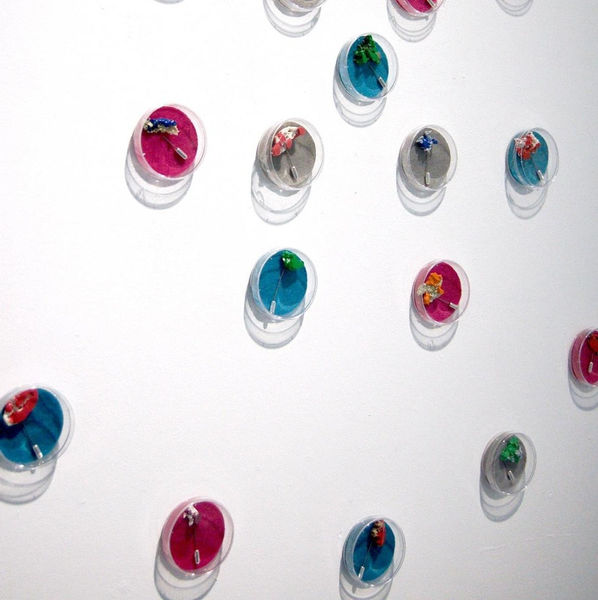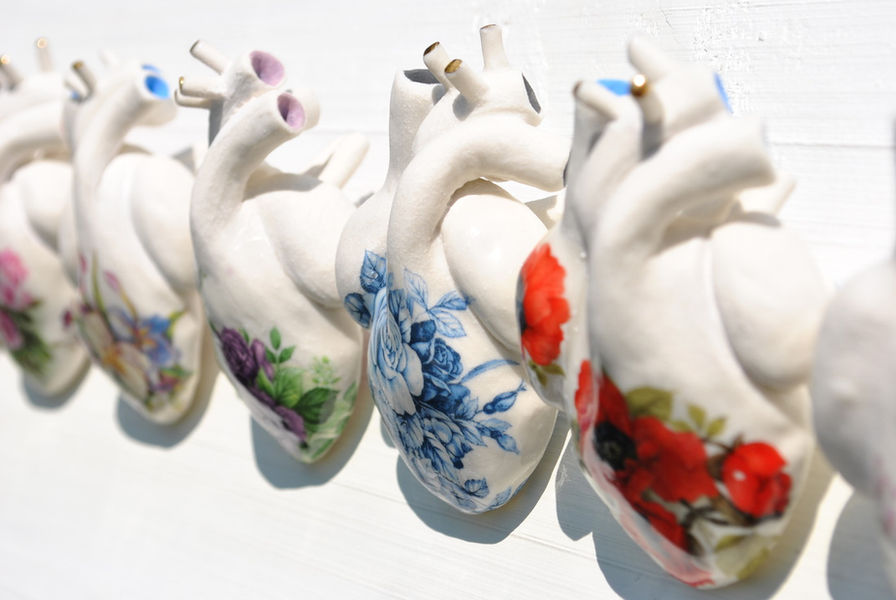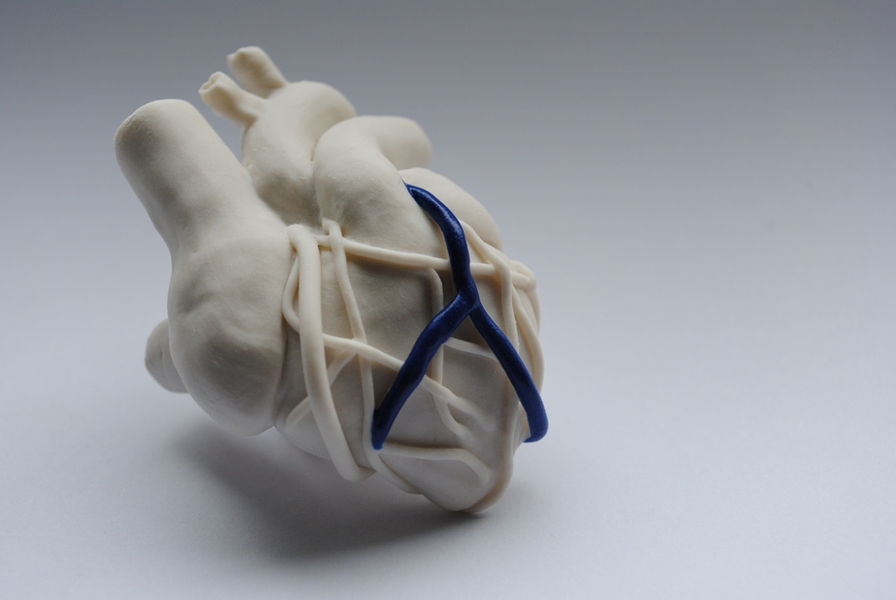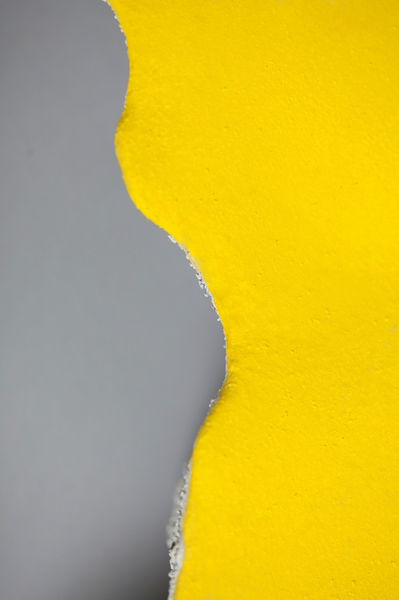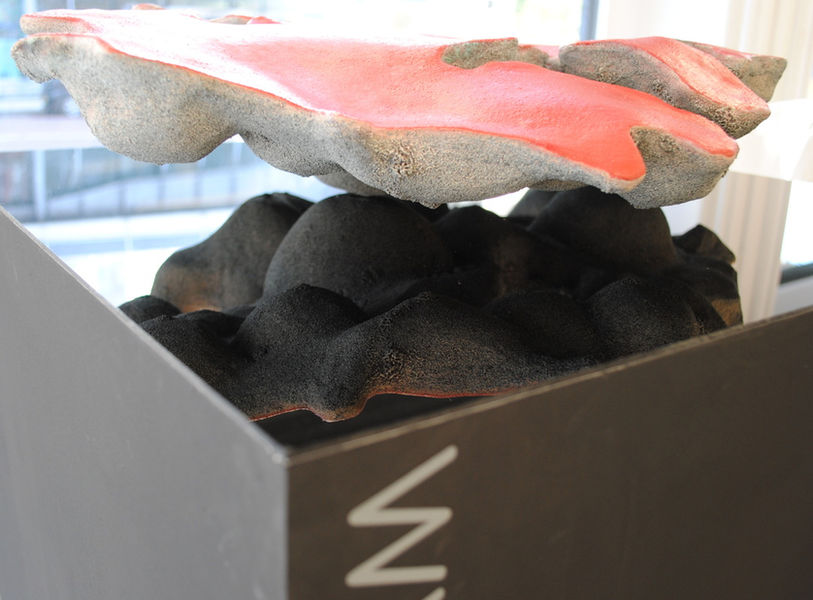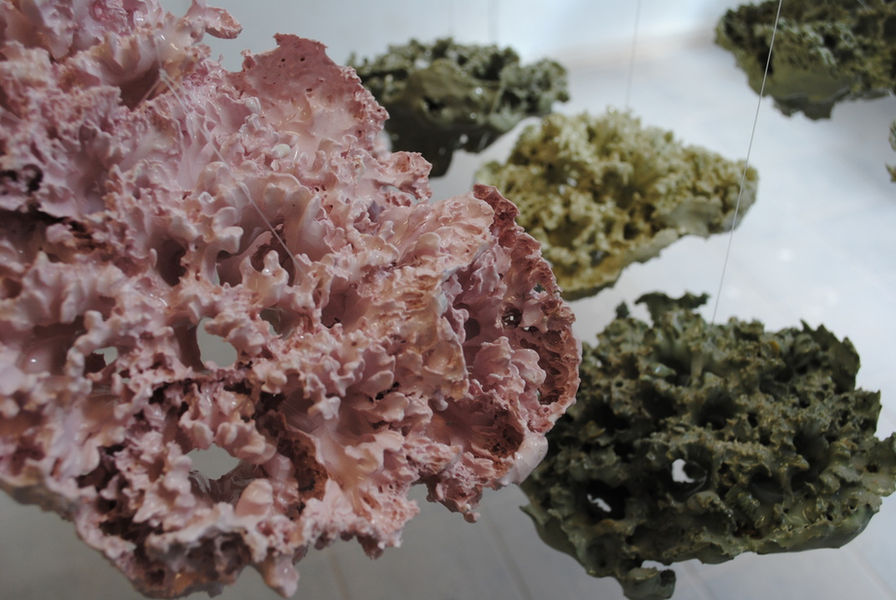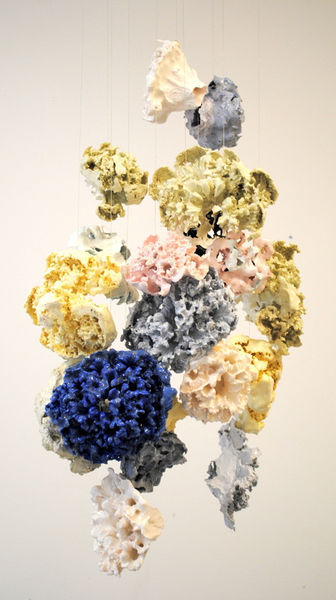Grief
2018
Black Clay, Stoneware, Handmade Grog, Polyurethane Resin
A grog is a raw ceramic material made from specific clays that are highly fired before being ground up, sieved and added to a clay body. If you add already fired ceramic (grog) to a soft un-fired clay, it works as a stabiliser prop in a weak clay body. Most importantly, this clay addition gives the clay body strength and texture, helping it dry and fire evenly. You often see this as a speckled surface on unglazed clay.
As a ceramicist, you learn to expect failure – whether it is clay drying unevenly causing warping before it’s fired, or a piece of work you spend months on exploding in the kiln because you did not dry it slowly enough or even accidentally dropping a perfect piece. I try to reduce my failures by learning and applying the new knowledge, but occasionally, something will slip through and surprise me. Instead of grieving for work that cannot be used, I wanted to find a function by using the failures to my advantage. In a cathartic process, I ground up every piece that warped, exploded or cracked and added it to a new clay body as a grog, giving relief from the grief of losing my old work.
In 2005, my Father was diagnosed with vascular dementia – he was 74 and I was 16. He was my biggest inspiration with the most incredible life and I watched him fade away. Over the years I saw him slowly, heartbreakingly, decline mentally and physically, before passing away in 2015. At the end my Dad was not the man I once knew to be my Father, he was a vessel that vaguely resembled him - but I found a tremendous comfort in his presence, his shape and touch.
I use my artistic practice as a maker to visually understand vascular dementia and how it affects. I believe ceramics is a way to capture memories through making.
This piece; ‘Grief’, was a way to process my loss by solidifying it into a form – a comforting, tactile and familiar form. After firing to a high, stoneware temperature and hand polishing the piece with a diamond sanding pads, the now soft, smooth, surface reveals the handmade grog flecked throughout the clay body. I deliberately chose not to traditionally glaze this form, instead allowing the freckles of failed work to be prominently present across the earthy surface.
The raw, black ceramic surface of this piece has been flooded with a suffocating bright yellow, polyurethane resin to represent the fake, plastic façade I wear to hide my private grief from my Father’s death.
Proteopathic Seeds
2015
Pin Brooches in petri dishes; Ming Porcelain, Plastic & Surgical Steel
In medicine, ‘proteopathy’ refers to a type of disease in which certain proteins become structurally abnormal and thereby disrupt the function of cells, tissues and organs of the body. The first abnormal protein cell cluster is referred to as a proteopathic seed. One of the most commonly known diseases that begins this way is Alzheimer’s disease. Slowly, these seeds grow and overtake regular proteins, disrupting the functioning of the brain with their chemical imbalance. Overtime, the brain suffers atrophy, memories are lost and barely physical reminders of the person remain.
Through collaboration, contemporary jewellery artist Robyn Galway and I produced Proteopathic Seed pins as part of MUD’s ‘Of a Person’. Made from porcelain, plastic & surgical steel, these seeds are to be worn with intention to deteriorate – to be shaped by the challenges everyday life brings, slowly losing its structure from the disease being worn externally. The high fired structure of the porcelain is embedded in the plastic, overtime the porcelain will depreciate away, mimicking the decline caused by the seed.
Proceeds from each Proteopathic Seed are donated in aid of Alzheimer's Society.
Proteopathic Seed Brooches were exhibited at Space CRAFT, Belfast as part of the 'Of a Person' Exhibition from 'MUD'
www.robyngalway.com
Love Can Leave You Breathless
2015
Hand-Built Ming Porcelain Inhalers, 24ct Gold Lustre, Open Stock Floral Decals
As a young girl, I was always fascinated with my Dads inhalers. I'd find these peculiar objects in random drawers around our home and wonder if they were so important why hadn’t I seen them being used and why were they hidden away. These could save his life, so why couldn't they be displayed in a little niche around the house instead of the various ceramic ornaments we had.
To me he was a strong man without weakness, he could achieve anything he put his mind to but it wasn't until his decline with Dementia worsened that I saw him use the inhalers. As I watched each little bit of him fade away, I found at certain moments underneath it all his deep love could leave me breathless.
Arteriosclerotic Hearts
2014
Ceramic Organs, Ming Porcelain & Black Clay, decals, gold lustre.Miniature Hearts & Large coiled Hearts.
A unique series of anatomically correct, porcelain ceramic organs derived from vascular dementia. This disease begins in the heart, causing strokes to affect the brain which causes impairment and memory loss. I looked to having a more literal image represent this debilitating disease and aid in raising awareness of what physically happens to the body and organs but also, as a daughter, the best way I can visualise the love for my Dad is through the symbol of a heart.
The design of each heart is inspired by ‘Arteriosclerosis’, a form of heart disease where the arteries become hardened. This is referred to as ‘Porcelain Aorta’ as the artery calcifies and loses its ability to function, it hardens and is comparable to the strength of porcelain and this is also the most common cause of Dementia.
I believe each of my ceramic hearts to be a memory, perhaps one that has been lost, ready to be found again and treasured.
Infarction [in-fahrk-shuhn]
2012
Large, Medium & Small series 2012Amaco velvet underglaze & volcanic glaze
The development of an area of dead tissue in the brain resulting from failure of blood supply.
"For ceramicist Jemma Millen the experience of caring for her father who has vascular dementia has prompted her to rethink her career.
Jemma graduated from the University of Ulster in 2012 with a First Class Honours in Fine and Applied Arts. Having spent the past six years helping to care for her father, she is taking time to focus on her practice.
Her father, who is 82, is now in a care home. Jemma says that caring for him and seeing how his condition deteriorated, has transformed her plans for a career.
“I helped look after my father for six years including my time at the University. It affected me a lot but I wanted to know what was going on inside his head. I began to look at how working with materials such as clay is something that can stimulate the brain and help people,” added Jemma.
Her own work for her degree was inspired based on photographs from her father’s PET Scans an imaging test which studies the brain.
“The PET scans have a range of colours that determine the level of activity in the brain from red (high activity) to blue (low activity). You can see how a person’s brain has deteriorated,” added Jemma.
Around the same time, Jemma had a flight over Strangford Lough and was struck by the similarity between the islands scattered around the lough and the pictures of the PET Scans.
“I saw all of those beautiful islands and saw the connection with the patterns in the brain scan. It was so emotional to see this huge land become so small from the air. Strangford Lough is a place that holds fond memories for me as it was one of the places that my dad used to drive the family to for picnics at the weekends.”
The result was her ‘Infarction Series’, which consists of five forms, derived from the scattered islands of Strangford Lough. Each piece represents an area of the brain with its surface a unique colour associated to the PET colour code.
Beneath the 'shore' line of the colour is a volcanic glaze. This harsh organic glaze contrasts the vibrating surface and mimics the notion of a disease with its sense of repetitive growth. Each surface acts to represent its stage in the disease with its form mimicking the fjord outline of the deterioration process in a human brain."
Brain Wave
2010
The negative space of 40 burnt out broccoli florets in porcelain paperclay, stained with mason stains, transparent glaze. Suspended in wave formation.
Inspired by images of brain atrophy in advanced Alzhiemer’s Disease, I used a process of burning out organic forms in the kiln, salvaging what was ‘left behind’ after this process to represent the gaped structural change of the brain.
Fragment Vases
2009
Slip-casted vases, Belleek slip, transparent glaze & open-stock decal transfers.
I’m fascinated with age and memory, specifically the value it incorporates into objects and people. I developed this by manipulating the worth of a classic ceramic form by de-constructing its structure and rebuilding the form again using a similar technique to golden joinery or ‘kintsugi’. This Japanese philosophy embraces and cherishes the crack or breakage as the history of the object, rather than something that is typically disguised. The integral pieces needed to regain the function of the vases were sold as brooches, giving the wearer the missing fragment of the vases memory.
The form of the vase was spun on the lathe out of plaster, this was cast and used as a mould to create the slip casted form. After it was brought up to 1000° Celsius for bisque, the vase was then fired to 1300° Celsius before it was smashed into fragments. One of three vases, this process was done collectively as to which one fragment could be joined to a piece from a different vase. Each fragment was then decaled separately before being brought together finally to reconstruct the form.
Not standing correctly and missing sections that are integral to its form, the vases become shadows of themselves, desperately clinging on to the vital and precious pieces that remain.













